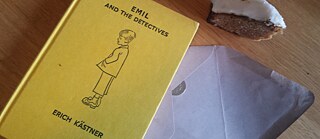December 2019
Erich Kästner: Emil and the Detectives

I had heard of Erich Kästner’s Emil and the Detectives (tr. Eileen Hall) long before I read it. It is perhaps the definitive German children’s classic: so popular that – unlike most of Kästner’s books – it escaped being banned by the Nazis, and since its publication in 1929 it’s been adapted for the screen a total of six times.
There’s always the danger of disappointment when reading kids’ books, particularly those published a while ago, as an adult. If you are unlucky, they may be flat or too fantastic or, worse, borrow from stereotypes which are jarring at best and offensive at worst. Luckily, Emil evades these dangers and is a genuine joy to read. The book’s refusal to moralise, which distinguished it when it was first published, plays its part in ensuring the book remains timeless.
Emil is getting the train to Berlin to spend the summer with family. In his pocket are £7, saved carefully by his mother to give to his grandmother. When the money is stolen, Emil decides to catch the thief himself – and thus begin his journeys through Berlin…
A confession at this point: I had always assumed the detectives of the title would be – you know – detectives. Grown ups. I’d pictured Emil as something like Tintin, a heroic boy detective in a world full of adults. And the nicest thing about the book is that I was wrong. The group which becomes the detectives are the Berlin kids Emil runs into, who – thrilled by the romance of his situation – band together to help him defeat the thief. And through the boys, eager and rowdy and disarming, Emil becomes, somehow, a remarkably democratic book. Emil’s problems aren’t solved by the book’s adults – nor are they solved by him alone. Unlike in a lot of children’s books, we don’t have one Wunderkind with a sidekick or gaggle of followers. Instead, the story’s turning point comes when close to a hundred boys are on the streets together – laughing, talking, jostling.
Eileen Hall’s translation of Emil and the Detectives dates back to 1959, and the language is somewhat dated (“’Gosh, what a lark!’ said the other boy. ‘Just like the pictures!’”), but this adds to a slight sense of nostalgia while reading, reminiscent of children’s classics like Swallows and Amazons or The Wind in the Willows. The nostalgia of Emil isn’t a sanitised one though – Emil’s mother is a widow who works hard to make ends meet, and the boy’s desperation on losing the money stems from his anxious awareness of this.
With Emil, Kästner arguably invented the children’s detective genre, which Enid Blyton so successfully developed – so if your kids are into Blyton, this might make a great Christmas present. For me though, it belongs firmly on the shelf with the best of the summer holiday adventure stories, Arthur Ransome’s Swallows and Amazon series, depicting a world in which adults are present but distant, where things are serious but never too serious, and where all proper adventures end with cherry slices and apple cake.
Reserve your copy of the book in our library today!
Back to the Book Blog